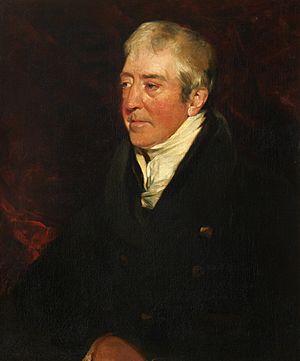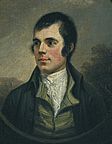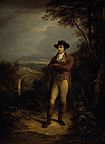Alexander Nasmyth facts for kids
Alexander Nasmyth (born September 9, 1758 – died April 10, 1840) was a Scottish artist. He was known for painting both portraits (pictures of people) and landscapes (pictures of nature). Alexander Nasmyth also helped design buildings and outdoor spaces.
Contents
Life Story of Alexander Nasmyth
Alexander Nasmyth was born in Edinburgh, Scotland. He went to the Royal High School and later studied art at the Trustees' Academy. When he was 16, a famous portrait painter named Allan Ramsay took him to London. Alexander helped Ramsay with his paintings there.
In 1778, Alexander came back to Edinburgh. He started working as a portrait painter. A friend, Patrick Miller of Dalswinton, offered him money to travel. So, in 1782, Alexander went to Italy for two years to learn more about art. In Italy, he spent most of his time painting landscapes. He even copied a painting by a famous artist named Claude Lorrain.
Return to Scotland and New Focus
When Alexander returned to Scotland, he continued painting portraits. He painted some in Ramsay's style. Many of his portraits showed groups of people outdoors. He became good friends with the famous poet Robert Burns. Alexander painted a well-known portrait of Burns, which you can see in the Scottish National Gallery today.
Alexander had strong beliefs about fairness and change. These ideas sometimes upset his wealthy clients in Edinburgh. Because of this, he started getting fewer requests for portraits. So, in 1792, he stopped painting portraits completely. He decided to focus only on landscape painting instead. He also started painting backgrounds for theaters, which he did for 30 years. In 1796, he even painted a huge, circular picture called a panorama.
Landscapes and Engineering Ideas
Alexander's landscape paintings always showed real places. Buildings and structures were often an important part of his art. Some of his paintings showed how new buildings would look in an area. For example, he painted Inverary from the Sea for a duke. It showed where a new lighthouse might be built.
Alexander was also very interested in engineering. He came up with many ideas that were later used widely. However, he never got a patent for any of them. In 1788, he was even on the crew of the world's first successful steamship. This ship was designed by William Symington and sailed on Dalswinton Loch.
Designing and Teaching
Wealthy Scottish families hired Alexander to improve their large estates. He designed the round temple over St Bernard's Well in Edinburgh in 1789. He also designed bridges at Almondell and Tongland. In 1815, he was asked to help plan the expansion of Edinburgh's New Town.
Alexander opened a drawing school. He taught many students how important drawing was for understanding the world. Some of his famous students included David Wilkie, David Roberts, and Clarkson Stanfield. He also taught Mary Somerville, a brilliant scientist and writer. He introduced her to many smart people in Edinburgh.
Alexander Nasmyth passed away at his home in Edinburgh. He was buried in St Cuthbert's Churchyard.
Family Life
Alexander Nasmyth married Barbara Foulis in 1786. She was the daughter of Sir James Foulis, 5th Baronet.
Alexander and Barbara had many children. Their six oldest daughters all became well-known artists. Their names were Jane, Barbara, Margaret, Elizabeth, Anne, and Charlotte. His oldest son, Patrick Nasmyth, also became a landscape painter. Another son, James Nasmyth, invented the steam hammer, a very important machine!
Building Designs
Alexander Nasmyth also worked as an architect, designing buildings and overall plans. Some of his notable projects include Rosneath House and Dunglass Castle. In 1810, he designed the Nasmyth Bridge as part of the Almondell Estate.
Gallery
-
View of Tantallon Castle and the Bass Rock
-
Robert Burns (1787)
Images for kids










